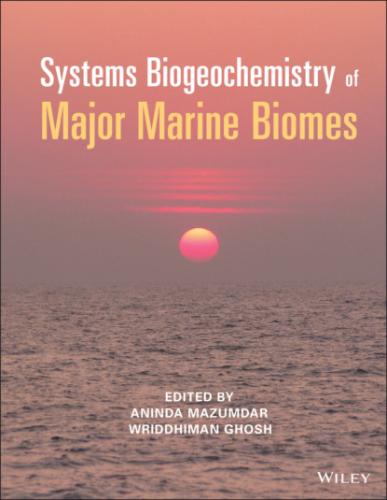L. Surya Prakash ESSO‐National Centre for Polar and Ocean Research Ministry of Earth Sciences Goa, India
Subhrangshu Mandal Department of Microbiology Bose Institute Kolkata, India
Sumit Mandal Department of Life Sciences Presidency University Kolkata, India
Jittu Mathai CSIR‐National Institute of Oceanography Goa, India
Aninda Mazumdar CSIR‐National Institute of Oceanography Goa, India
Patrick Meister Department of Geodynamics and Sedimentology University of Vienna Vienna, Austria
Rahul Mohan ESSO‐National Centre for Polar and Ocean Research (NCPOR) Ministry of Earth Sciences Goa, India
Nibendu Mondal Department of Microbiology Bose Institute Kolkata, India
Sambhaji Mote CSIR‐National Institute of Oceanography Goa, India
Mandar Nanajkar CSIR‐National Institute of Oceanography Goa, India
Vidya P. Jayapalan ESSO‐National Centre for Polar and Ocean Research (NCPOR) Ministry of Earth Sciences Goa, India
Sabu Prabhakaran ESSO‐National Centre for Polar and Ocean Research (NCPOR) Ministry of Earth Sciences Goa, India
Shramik Patil ESSO‐National Centre for Polar and Ocean Research (NCPOR) Ministry of Earth Sciences Goa, India
Jitendra K. Pattanaik Department of Geology Central University of Punjab Bathinda, India
Aditya Peketi CSIR‐National Institute of Oceanography Goa, India
Venigalla P. Rao CSIR‐National Institute of Oceanography Goa, India; and Department of Civil Engineering Vignan’s University Guntur, India
Carolina Reyes Department of Environmental Geosciences University of Vienna Vienna, Austria
Khem C. Saini Centre for Biosciences Central University of Punjab Bathinda, India
Jagannath Sarkar Department of Microbiology Bose Institute Kolkata, India
Sabyasachi Sautya Regional Centre, CSIR‐National Institute of Oceanography Mumbai, India
Suhas S. Shetye CSIR‐National Institute of Oceanography Goa, India
Rupesh K. Sinha ESSO‐National Centre for Polar and Ocean Research (NCPOR) Ministry of Earth Sciences Goa, India
Kalyani Sivan Academy of Scientific and Innovative Research (AcSIR) Ghaziabad, India; and CSIR‐National Institute of Oceanography Goa, India
Melena Soares ESSO‐National Centre for Polar and Ocean Research (NCPOR) Ministry of Earth Sciences Goa, India
Herald Strauss Institut für Geologie und Paläontologie Westfälische Wilhelms‐Universität Münster Münster, Germany
Sarat C. Tripathy ESSO‐National Centre for Polar and Ocean Research (NCPOR) Ministry of Earth Sciences Goa, India
PREFACE
Biological processes have profound roles in the chemical transformations of the marine realm. The nature and extent of biological activities, in turn, are controlled by a number of physical and chemical phenomena such as interaction of the ocean with the atmosphere and earth’s crust, oceanic upwelling, oxygenation, sediment accumulation, and inorganic and organic matter fluxes in dissolved and particulate forms from the land and the deep earth. The overall biogeochemical dynamics of the water column and sediment fluid also exert feedback influences on the structure and function of the biota, and, in the entire process, the system evolves holistically in time and space. In this context, a marine biogeochemical system can be thought of as a geographically and geologically defined physiography that transcends latitudes, longitudes and water‐depths of the global ocean, and has its characteristic geobiological framework, overarching all the spatiotemporal dynamics of its structural (e.g. chemical and biological species) and functional (e.g. reactions and transformation) components.
Comprehensive understanding of marine biogeochemical regimes entails systemic knowledge of the biomes. Historically, studies of inorganic and organic geochemistry for water‐columns and sediments (including both past and present records) contributed the most in deciphering biogeochemical processes within the marine realm. In recent times, remarkable advances in high‐throughput meta‐omics‐based microbiological research, and molecular‐taxonomy‐based understanding of benthic ecology, have afforded increasing knowledge interfaces between preserved geochemical records and ecosystem structure/function. Such cross‐talks of disciplines have led to the discovery of a number of novel (and often cryptic) biogeochemical processes within the global ocean that were impossible to have been revealed previously from preserved chemical records alone. At the same time, increasing cross‐disciplinary interfaces have also given rise to biogeochemical enigmas, of which some may well be the potential seeds of future paradigm changes in marine biogeochemistry. In this intellectual landscape, where our understanding of in situ biological processes, their geological manifestations, and cybernetic controls, are evolving faster than ever, this book adopts a systems‐based approach to integrate and update the information available on the geochemistry, geophysics, biology and ecology of four major categories of marine physiography: continental margins, ocean depths, polar oceans, and biophysically extreme environments. The idea, at large, is to envision holistic pictures of all biogeochemical happenings within distinct systems of these oceanic provinces.
While some of the biogeochemical regimes mulled over hold crucial implications for planetary health and biosphere sustainability (by virtue of being the bellwethers of perturbations brought about by anthropogenic interference, pollution, global warming and/or climate change), others are central to the understanding of the Earth’s early biosphere, so their geobiologies hold critical implications for life‐detection during space‐exploration missions and potential habitability of differently constituted oceanic systems in extraterrestrial locations.
We expect the biome‐based systemic perspective to complement the traditional way of looking at marine biogeochemistry from the standpoint of individual elemental cycles. Systemic consideration of biogeochemical provinces of the global ocean would not only provide an intellectual baseline for integrating chemical records with biome structures/functions but also lay the foundation of holistic policy frameworks for sustainable utilization of marine resources, risk avoidance, and disaster management.
Aninda Mazumdar Geological Oceanography CSIR‐National Institute of Oceanography, India
Wriddhiman Ghosh Department of Microbiology Bose Institute, India
1 Biogeochemistry of Marine Oxygen Minimum Zones with Special Emphasis on the Northern Indian Ocean
Svetlana Fernandes1,†, Subhrangshu Mandal2,†, Kalyani Sivan1,3, Aditya Peketi1, and Aninda Mazumdar1*
1 CSIR‐National Institute of Oceanography, Dona Paula, Goa , 403004, India
2 Department of Microbiology, Bose Institute, P‐1/12 CIT Scheme VIIM, Kolkata, 700054, West Bengal, India
3 Academy of Scientific and Innovative Research (AcSIR), Ghaziabad 201002, India
* Corresponding Author: Aninda Mazumdar ([email protected]) ORCiD code: 0000‐0002‐7897‐1646
